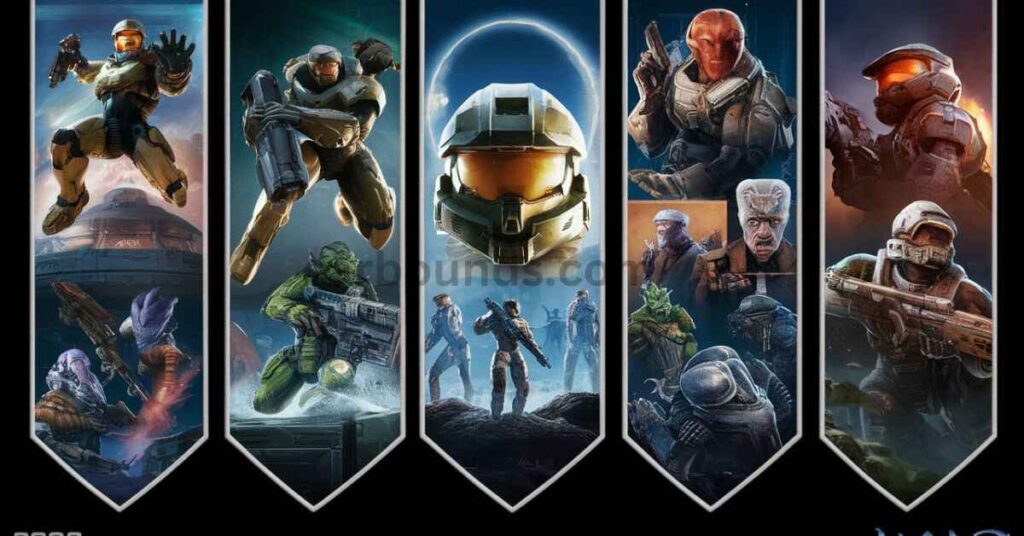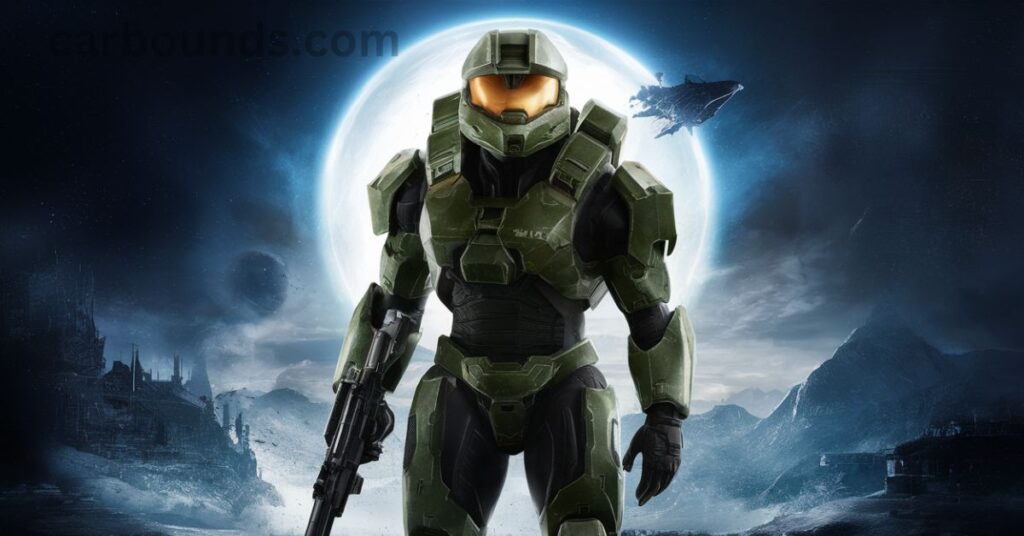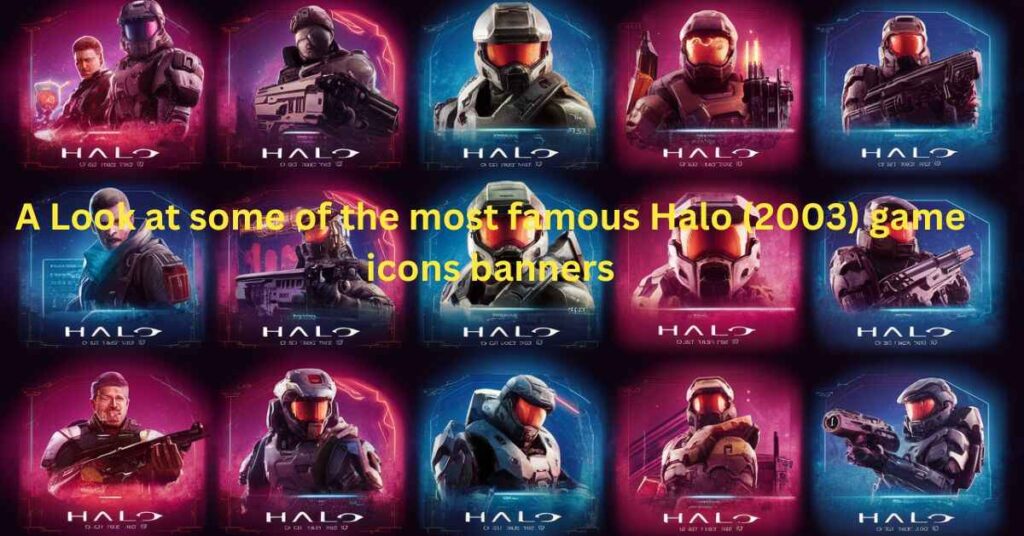Halo (2003) Game Icons Banners: The Visual Legacy of a Gaming Revolution
In the vast cosmos of video game history, few titles shine as brightly as Halo (2003). This groundbreaking first-person shooter not only redefined console gaming but also left an indelible mark on pop culture. Among its many innovations, the game’s iconic visual elements—particularly its game icons and banners—played a crucial role in cementing Halo’s place in the pantheon of gaming greats. Let’s embark on a deep dive into the world of Halo (2003) game icons banners, exploring their significance, design, and lasting impact on the gaming industry. Halo (2003) Game Icons Banners.
What are the Halo (2003) game icons banners?

Halo (2003) game icons banners are the visual symbols and graphical elements that represent various aspects of the game’s universe. These icons and banners served multiple purposes:
- Navigation aids within the game’s menu systems
- Visual shorthand for weapons, vehicles, and characters
- Multiplayer team identifiers
- Loading screen elements
- Marketing and promotional materials
The designers at Bungie Studios crafted these icons with meticulous attention to detail, ensuring they not only looked appealing but also conveyed information quickly and effectively. From the instantly recognizable Master Chief helmet to the mysterious Halo ring itself, these symbols became the visual language of the Halo universe. Halo (2003) Game Icons Banners.
What is the significance of Halo’s (2003) game icons banners?
The importance of Halo’s iconic imagery cannot be overstated. Let’s break down the key aspects of their significance:

They are Iconic
The Halo (2003) game icon banners transcended their original purpose to become symbols of the entire franchise. The Master Chief’s helmet, for instance, is now synonymous with Xbox gaming itself. These icons have appeared on everything from t-shirts to energy drink cans, becoming cultural touchstones that extend far beyond the gaming community.
They are Excellent for Communication
In the fast-paced world of first-person shooters, clear and instant communication is crucial. Halo’s icons excelled at conveying information at a glance. Whether it was indicating available weapons, vehicle types, or game modes, players could quickly understand their options without the need for text explanations.
They just look cool
Let’s face it—Halo’s visual design was simply awesome. The futuristic, sleek aesthetics of the icons and banners appealed to players’ sense of style and immersion. The blend of military-inspired designs with alien technology created a unique visual language that stood out from other games of the era. Halo (2003) Game Icons Banners.
They Build a Sense of Community
Halo (2003) game icon banners played a significant role in fostering a sense of community among players. In multiplayer modes, team banners helped players quickly identify allies and enemies. Custom banners allowed players to express their personality and allegiances, creating a visual shorthand for clan membership and individual identity within the game.
They are a great Marketing and Promotional Tool
Microsoft recognized the power of Halo’s iconic imagery and leveraged it extensively in marketing campaigns. The simple, recognizable designs of the game’s icons and banners made them perfect for merchandise, advertisements, and cross-promotions. This helped extend Halo’s reach beyond the gaming world and into mainstream popular culture.
A Look at some of the most famous Halo (2003) game icons banners

Let’s examine some of the most memorable icons and banners from Halo (2003):
Master Chief Icon
The stylized Spartan helmet of Master Chief is perhaps the most recognizable symbol from Halo. Its sleek design and reflective visor became instantly iconic, representing not just the character but the entire Halo franchise.
“The Master Chief icon is more than just a logo—it’s a symbol of heroism and the human spirit’s triumph against overwhelming odds.” – Bonnie Ross, Head of 343 Industries
Pillar of Autumn banner
The UNSC Pillar of Autumn, the spaceship that serves as the player’s home base at the start of the game, was represented by a distinctive banner. This icon symbolized humanity’s military might and the struggle against the Covenant forces.
Covenant banners
The alien Covenant faction had its own set of striking icons and banners. These often featured curved, organic shapes contrasting with the more angular human designs, visually reinforcing the alien nature of the Covenant.
| Covenant Race | Banner Description |
|---|---|
| Elites | Sleek, sword-like emblem |
| Grunts | Simplistic, triangular design |
| Hunters | Heavy, shield-inspired icon |
Halo ring-loading screens
The Halo ring itself served as a powerful visual motif throughout the game. Its use in loading screens was particularly memorable, with the ring slowly forming as the level loaded, building anticipation for the action to come. Halo (2003) Game Icons Banners.
The Legacy of Halo (2003) Game Icons Banners
The impact of Halo (2003)’s visual design extends far beyond the original game. Subsequent entries in the series have built upon and refined these iconic designs, but the core visual language established in 2003 remains intact. Many other games have since adopted similar icon-based systems for conveying information, a testament to Halo’s influence on game design.
Creating Your Halo-Inspired Icons and Banners
For fans looking to create their Halo-inspired icons and banners, here are some tips:
- Study the original designs closely to understand their simplicity and effectiveness
- Use vector graphics software like Adobe Illustrator for clean, scalable designs
- Stick to a limited color palette inspired by the game’s aesthetic
- Focus on bold, easily recognizable shapes
- Consider the icon’s purpose and ensure it communicates clearly at small sizes
FAQs
- What’s the most recognizable Halo (2003) icon?
The Master Chief helmet icon is widely considered the most recognizable symbol from Halo (2003). - How have Halo icons changed since the 2003 release?
While the core designs have remained consistent, later games have refined and modernized the icons, adding more detail and depth. - Can I use Halo icons for my projects?
Halo icons are copyrighted by Microsoft. For personal use, fan art is generally tolerated, but commercial use requires official licensing. - Were there any controversial Halo (2003) icons or banners?
While not particularly controversial, some players found the Flood parasites’ icons unsettling, which was likely intentional. - How did Halo (2003) icons differ from other FPS games of the time?
Halo’s icons were more stylized and cohesive compared to the more realistic or simplistic icons found in contemporary FPS games.
Conclusion
The Halo (2003) game icon banners represent more than just eye-catching graphics—they’re a crucial part of gaming history. These visual elements helped define the Halo experience, facilitating gameplay, building community, and extending the game’s influence far beyond the confines of the Xbox. As we look back on this groundbreaking title, it’s clear that its iconic visual design played a significant role in elevating Halo from a mere game to a cultural phenomenon.
Whether you’re a long-time fan or a newcomer to the series, take a moment to appreciate the artistry and thought that went into creating these enduring symbols. The legacy of Halo (2003) game icons banners continues to influence game design and pop culture, reminding us of the power of effective visual communication in the digital age.










